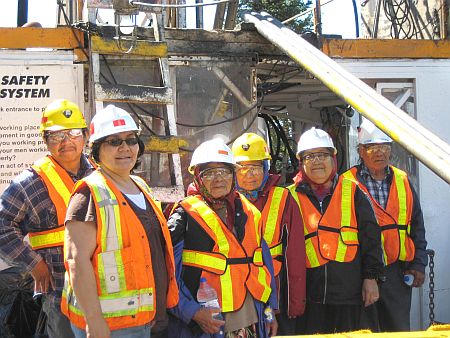
A group of northwestern Ontario First Nation communities and representatives from Goldcorp Inc.'s Musselwhite Mine have moved bureaucratic mountains in persuading the Ontario government to extend the province's electrical power grid to the region.
Both parties made attempts to bend the ear of government to obtain a reliable source of energy to this remote area, but both sides failed until they made a collective plea. Now, transmission lines between Nipigon and Pickle Lake have been placed on Hydro One's agenda as one of 20 projects in an ambitious $2.3 billion green-energy makeover by the province."Individually, we weren't getting anywhere, but together we got results," said Adele Faubert, Goldcorp's manager of Aboriginal affairs.The partnership between Goldcorp and the First Nation communities dates back to the late 1980s. The Musselwhite Agreement was one of the first Impact Benefit Agreements negotiated in Ontario. First signed in 1996, the five-year deal was renewed in both 2001 and 2006.Zeb Kenequanash, economic development officer for North Caribou Lake First Nation, said keeping an open line of communication is of utmost importance.
"Be respectful, honest and fair, and First Nation communities will accept and honour that," he said.
North Caribou Lake has a population of 780 and is located approximately 320 kilometres north of Sioux Lookout. It is one of four First Nation communities and two tribal councils that have negotiated the sharing of resources from the Musselwhite gold mine, originally owned and operated by Placer Dome.
Initially, representatives of the fly-in operation met with First Nation leaders during the feasibility work for the mine, according to Faubert.
Local groups were invited to come to the table to listen and see if or how they would be impacted by the mine. Much of the communication was face to face within the communities. On one occasion, a group from North Caribou Lake was taken to a mine that had ceased operations to demonstrate what a rehabilitated mine site looks like.
Partnership
Over time, a working partnership evolved."It is about building relationships with community leaders and members," said Faubert. "You don't do it when you need something. It has to be a continuous process."
It is important to understand each community's needs, priorities and differences, she added.
Faubert would like to see the provincial government take more responsibility for defining consultation and be more consistent in those expectations from one ministry to another.
"I think the government should develop an Exploration and Mining 101 (course) for the communities because claim staking and preliminary exploration drilling doesn't necessarily mean there is going to be a mine. ... They either get their hopes up or they become fearful and/or defensive because they haven't been fully consulted.
"On the flip side, industry needs to understand the governance of a First Nation community and how they are set up in their decision-making process. Typically, it is from the bottom up. The chief may be the public "go-to person" for outsiders, but he or she doesn't make all the decisions. It is brought back to the community members, the elders, the trappers, the people who may be physically impacted by the project."
Kenequanash said mining companies also need to understand his people's connection to the land.
"The land and resources were given to us by our creator for us to share with other cultures," he said. "They have to understand that they have to share the resources with us."
Consultation is ongoing between the mining company and communities. Within the IBA, Kenequanash said there are mechanisms in place to deal with any conflicts that may arise. He called it a "trigger," meaning if an issue arises that is of concern, it is identified and a process ensues to discuss and resolve it.
"We like to hear each other out. There is always a common ground," he said, emphasizing that it is important to listen to each other and that conflict or antagonism at a meeting is not acceptable."
Revenue sharing
Other negotiated aspects within the agreement are revenue sharing and employment. A target of 30 per cent First Nation employment was set for the signatory and affiliate communities. Currently, 24 per cent of people employed at the mine are Aboriginal, but only 14 per cent of Musselwhite's workforce is from the signatory First Nations due to the limited educational opportunities available to members of remote communities.In order to assist in education and training First Nation people, Goldcorp has entered into a partnership with the Sioux Hudson Literacy Council to develop a mining prep program for the signatory communities.
"We've taken the literacy upgrading program and added Musselwhite-specific information. Anybody who completes the 30-week upgrading course achieves the equivalent of Grade 10, an entry-level requirement for underground mining at Musselwhite."
The company organizes site tours, participates in job fairs and stages ceremonies to mark the beginning and end of the effluent discharge season.
"We have an opening ceremony at which elders, ministers, and youth come to the mine site and offer prayers and song in hopes of a good discharge season," said Faubert. "We provide transportation to the mine site."
An international employer with operations worldwide, Goldcorp operates a cultural awareness program to help employees recognize and resolve misunderstandings that may arise due to cultural differences.
Keeping the channels of communication open helps build relationships and achieves goals that benefit both sides.
www.goldcorp.com
www.windigo.on.ca/northcaribou.htm
Best practices
- Listen to each other
- Understand the First Nation decision-making process
- Be fair and respectful
- Make the effort to understand cultural differences
- Building relationships is a continuous process

